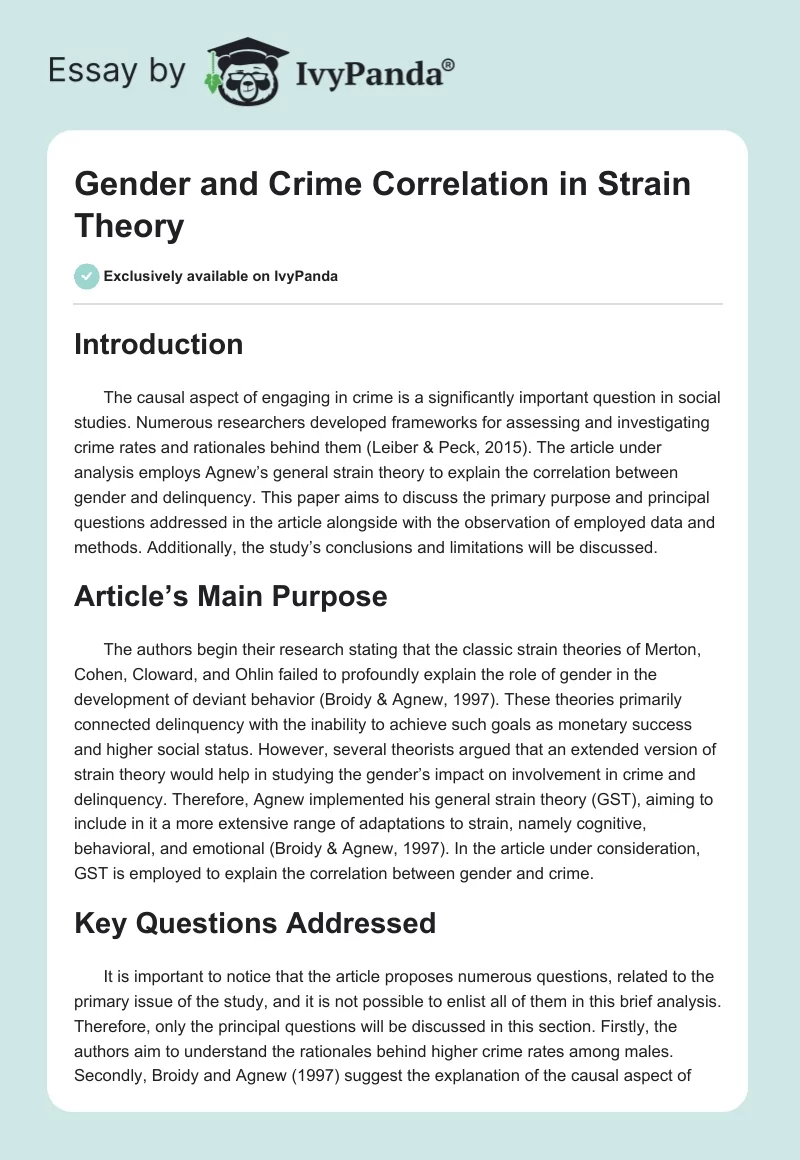Introduction
The causal aspect of engaging in crime is a significantly important question in social studies. Numerous researchers developed frameworks for assessing and investigating crime rates and rationales behind them (Leiber & Peck, 2015). The article under analysis employs Agnew’s general strain theory to explain the correlation between gender and delinquency. This paper aims to discuss the primary purpose and principal questions addressed in the article alongside with the observation of employed data and methods. Additionally, the study’s conclusions and limitations will be discussed.
Article’s Main Purpose
The authors begin their research stating that the classic strain theories of Merton, Cohen, Cloward, and Ohlin failed to profoundly explain the role of gender in the development of deviant behavior (Broidy & Agnew, 1997). These theories primarily connected delinquency with the inability to achieve such goals as monetary success and higher social status. However, several theorists argued that an extended version of strain theory would help in studying the gender’s impact on involvement in crime and delinquency. Therefore, Agnew implemented his general strain theory (GST), aiming to include in it a more extensive range of adaptations to strain, namely cognitive, behavioral, and emotional (Broidy & Agnew, 1997). In the article under consideration, GST is employed to explain the correlation between gender and crime.
Key Questions Addressed
It is important to notice that the article proposes numerous questions, related to the primary issue of the study, and it is not possible to enlist all of them in this brief analysis. Therefore, only the principal questions will be discussed in this section. Firstly, the authors aim to understand the rationales behind higher crime rates among males. Secondly, Broidy and Agnew (1997) suggest the explanation of the causal aspect of females’ engagement in delinquency. Additionally, the authors investigate gender differences in the emotional response to various kinds of strain, which are not equal for males and females.
Data and Methods Employed
It is possible to state that Broidy and Agnew (1997) employ the exploratory analysis in their article. Notably, they do not use any statistical data sets or samples and, respectively, no statistical methods are used. Instead of it, the authors explore and review numerous scholarly sources, including works by sociologists and psychologists, to discover previously unknown interrelations between crime and gender. Broidy and Agnew (1997) do not intend to generalize their study’s results, but instead, they set the foundation for future research on the topic.
Article’s Conclusions and Limitations
Further, it is essential to discuss the article’s primary conclusions and limitations. First of all, the authors observe that males and females are experiencing different types of strain, and that is why their deviant behavior differs. Secondly, the emotional response to strain also depends on gender. Broidy and Agnew (1997) state that males primarily respond with anger and aggression, while females tend to develop depression, self-guilt, and anxiety. Thirdly, men are more likely to conduct serious violent crimes due to the differences in coping and social support. Additionally, it is stated that “females experience as much or more strain than do males but are less likely to engage in crime – especially serious crime” (Broidy & Agnew, 1997, p. 294). Concerning the limitations of the research, it should be mentioned that Agnew did not fully develop his general strain theory. Therefore, it is of high importance that the future researchers would specify the following: how much strain is experienced by particular groups, what are the differences in coping with strain, and why the groups cope in a distinct manner (Broidy & Agnew, 1997).
References
Broidy, L., & Agnew, R. (1997). Gender and crime: A general strain theory perspective. Journal of Research in Crime and Delinquency, 34(3), 275-306.
Leiber, M. J., & Peck, J. H. (2015). Race, gender, crime severity, and decision making in the juvenile justice system. Crime & Delinquency, 61(6), 771-797.


